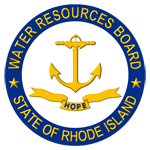Programs
Water Facilities Assistance
Since 1983, the Water Resources Board has administered a grant program to finance up to 50% of design and construction costs for new public water supply facilities. Funding for this program is provided through periodic general obligation bonds passed by statewide voter referendum. To date, over twenty major system improvements benefiting fourteen water districts have been funded. The program allowed construction of the Bristol County Water Authority (BCWA) interconnection to the Providence and East Providence water systems, relieving the historically troublesome supply problems for Barrington, Bristol and Warren. The Board continues to work with BCWA regarding rehabilitation of aging supply, transmission, and treatment facilities. The Water Facilities Assistance Program has been a model of cooperation between state government and local water suppliers.
During 2004, work continued to complete construction on a 12-million gallon addition to the Providence Water Supply Board’s Longview Reservoir, a 3-million gallon, water storage tank, and the upgrade of three major pump stations. Funded through revenue bonds sold by Board Corporate, the work addresses the inadequate water pressure in the high service area and fire protection in the downtown Providence retail district.
The Water Resources Board is working with all major public water suppliers throughout the state to establish much needed emergency interconnections between systems. Emergency water System interconnections provide redundancy of supply and the ability to address water emergencies rapidly and efficiently across water supply districts should they occur. This innovative program was implemented in 1999. Ten interconnections have been constructed to date and three more are under construction or under agreement, representing grants of $5 million dollars. The North Tiverton Fire District continues constructing an interconnection with Fall River, Massachusetts. This project provides the ability to supply redundancy to the Stone Bridge Fire District treatment plant at Stafford Pond. This project is a cooperative, regional effort between Rhode Island and Massachusetts, and ensures that water will be available should an emergency occur. The second project will provide emergency water resources to South Kingstown from United Water of Rhode Island. Finally, during 2004, the Martin Street reconstruction project will connect Lincoln and Cumberland, and is scheduled for completion in 2005. The Rhode Island Water Resources Board has been recognized for this innovative program, with many states expressing interest in developing a similar program. This program is funded with general obligation bond dollars. The goal is to continue until all water supply systems in the state have secondary water supply sources available should an emergency occur.
Supplemental Water Supply Study Phases I and II
During 2004, the Water Resources Board joined the Providence Water Supply Board to evaluate options for developing supplemental water supplies for the central service area of the state. Phase I of the study identifies sources and systems capable of augmenting up to 40 million gallons of water per day in emergency circumstances. The study identifies a combination of nearby water system interconnections and new or abandoned groundwater sources to sustain emergency water demand for over 600,000 people served within the central portion of the state in case of failure in the Scituate Reservoir system. Phase II of this study extends to include the state’s remaining water supply service areas. Initiated by the Board, the results will identify potential methods for supply augmentation for individual water systems, as well as provide additional information to support the Emergency Interconnection, Water Allocation, and the Water Supply Systems Management programs.

